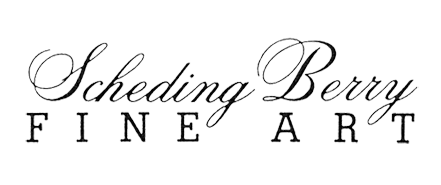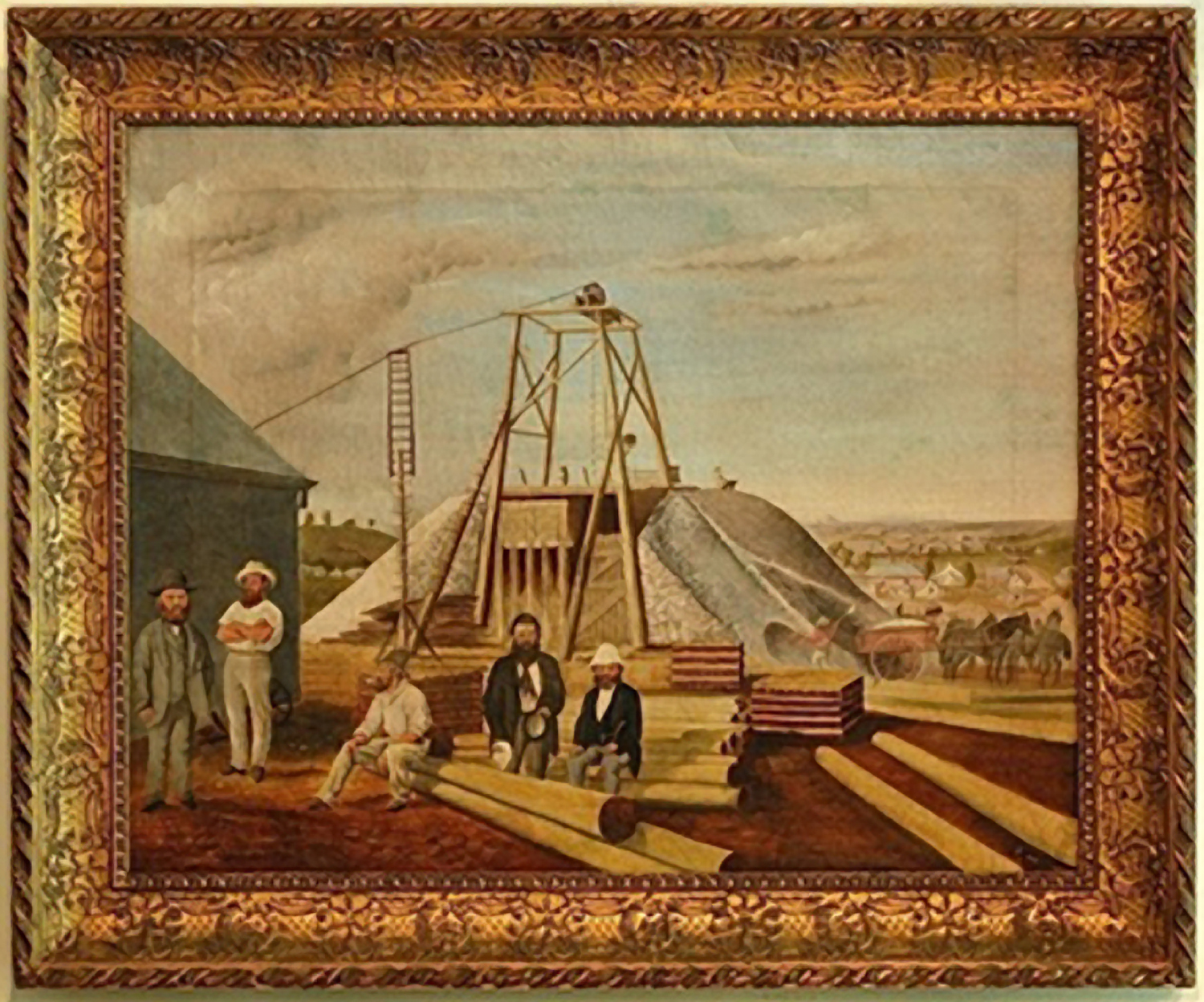William Jamieson Allom
Five Mad Germans’, Day Dawn Mine, Charters Towers,
Oil on canvas
Signed ‘W J [in monogram] Allom’ lr , Inscribed ‘no 61’ in paint on reverse of canvas (possibly an exhibition number).
48.5
x 61.4
cm
SOLD
Literature:
Artist of the Gold Rush, Don Johnson, The Prospector, 3 December, 1987. ‘Friedrich Pfeiffer- A Man of Vision’, Northern Miner, 29 August 1980. Charters Towers People and Places, Michael Brumby, Charters Towers and Dalrymple Archives Group, 2010. The Boss Day Dawner, Don Johnson (1994), unpublished manuscript (not sighted). Charters Towers 1887, Celebrating the Photographic Work of Carey Jamieson Allom and Arthur Riddulph Bailey, Michael Illustrated: Another version of the painting is illustrated in the article ‘Artist of the Gold Rush’ in The Prospector, December 3, 1987, p17 and in Charters Towers People and Places, by Michael Brumby, p110. See also: Brumby, Charters Towers and Dalrymple Group, 2004. Charters Towers, World Connections, Michael Brumby, Charters Towers and Dalrymple Archives Group, 2012. Ravenswood Times and Mining Record, October 1872. Brisbane Courier, 11 May 1881. Design and Art Australia Online.
William Allom was known as ‘The Charters Towers Painter’. The five owners of the mine depicted are: (l to r) unknown, Tom Christian, Friedrich Pfeiffer, unknown and John Romberg.
The 1870s to the 1890s were boom years in Charters Towers, to the extent that the city hosted its own Stock Exchange. A railway between Charters Towers and the coastal port of Townsville was completed in December 1882. During this period, the population was approximately 30,000, making Charters Towers Queensland's largest city outside of Brisbane. The city was affectionately known as 'The World' as it was said that anything one might desire could be had in this city. Between 1861 and 1878, 17,000 Germans moved to Queensland. Some 250-300 Germans lived in Charters Towers including ‘the Five Mad Germans’: Friedrich Pfeiffer, Christian Paradies, Carl Riedrich, Louis Haman and John Romberg who, with others, had interests in the Day Dawn PC (Principal Claim) Mine. (Because of the changing ownership of the mine it cannot be certain whether these five Germans were exactly the same five miners depicted by Allom in the painting. These miners have been identified by Don Johnson, 1946-92, historian of Charters Towers). Pfeiffer came to Charters Towers in late 1873, after 17 luckless years searching for gold elsewhere. He almost immediately took up the Day Dawn lease. However, a succession of partners and supplementary income were needed to maintain the persistent German in his search for gold and the shaft went down 300 feet before rich gold-bearing ore was found in 1878. Pfeiffer held a quarter share when the gold was found and he worked it for the next 9 years. The mine was then sold to an English company for 500,000 pounds in June 1887. Pfeiffer married Mary Donovan in 1882, and built Day Dawn House in 1881-83 with its 23 rooms, immediately adjacent to the mine, in Day Dawn Street. Later he was a principal benefactor to the Lutheran Church. John Romberg owned a sixteenth share in the mine. In 1877 a bucket dropped 150 feet striking him in the head, and he took some time to recover. Through the generosity of a friend he was able to keep his share. William Jamieson Allom was born in Buckinghamshire on 25 July 1832, to Samuel Richard Allom, an Anglican clergyman. He was trained as a draughtsman-architect. William arrived in Australia on 23 November 1852. The ship on which he was travelling, the Margaret Brock, was wrecked off Cape Jaffa in South Australia, and the passengers walked to Adelaide from there. William then travelled to Auckland, New Zealand with his brothers, where he met his future wife, Hannah Scotter. They were married on 18 December 1860 by John Dunmore Lang in Sydney, later having 12 children. William left Sydney for Rockhampton in August 1864, and moved to Bowen in June 1865 where he operated an auctioneering business. His first known sketch is titled Bowen Agricultural Show. In 1872 he left Bowen for Ravenswood, which was then the inland capital of North Queensland. The family journey had taken 14 days, by horse and dray. In October 1872 the 'Ravenswood Times and Mining Record' carried advertisements for an exhibition of his painting. Titles of his works at this time included Watching the Troopers, Ravenswood and Mother’s Little Valentine. He edited the newspaper between 1875 and 1877 and also continued as an auctioneer, He left Ravenswood for Charters Towers in December 1877. The Queensland Post Office Directory has William listed as an artist in 1889, with the address as Aland Street. The 1890 to 1892 issues of the directory show a W. J. Allom as an auctioneer in Charters Towers, and it is thought that during this period he may also have run the local Charters Towers newspaper. However, increasingly he turned to painting and calligraphy for a living. He became the artist of the town, doing portraits, landscapes and illuminated addresses. His son Corey Jamieson Allom had begun work as a photographer, initially in the firm Stamp & Allom, and from 1888 as Allom & Bailey. It is likely the owners depicted in The Five Mad Germans were painted from photographic portraits. William eventually left Charters Towers on 17 December 1893 and died in Sydney on 24 June 1902. He was buried in the Waverley Cemetery. William exhibited his artworks at such events as the Queensland National Association Exhibition in Brisbane in August 1884, exhibiting no. 1149 ‘Landscape’ £42.0.0 and he sent two paintings to the Colonial and Indian Exhibition in London in 1886. Other known Allom titles are Saturday Night, Mosman Street, 1874 and The Opening of the Railway, 1884. An interesting painting by Allom, which appears to show a fight between miners, can be seen in a photograph of a display of wax sculptures and paintings by Allom shown in Sydney in 1900 (the photograph is held by the State Library of South Australia, ref. no. PRG 280/1/1/65 and is reproduced below).
Another version of the Day Dawn painting by Allom (showing one or possibly two different owners) is illustrated in the article ‘Artist of the Gold Rush’ in The Prospector, December 3, 1987, p17 (reproduced below), and in Charters Towers People and Places, by Michael Brumby, Charters Towers and Dalrymple Archives Group, 2010, page 110.
Surviving oil paintings by Allom are rare. Only two of his paintings appear to be in public institutions. Like Five Mad Germans, both are wonderful paintings. The very impressive View of Charters Towersis in the State Library of Queensland, John Oxley Library collection. This panoramic painting shows the mining town at the height of its prosperity when it was known as ‘The World’. At left is the Mills Day Dawn United Mine, known as the ‘Show Mine of the Colony’. This view was exhibited in Artists of the Tropics, Blighted Paradise at the State Library of Queensland. The other important Allom painting, Townville, painted from the David Brands Slipway, Ross Creek, 1884, once owned by James Burns, is now in the Townville Art Gallery.




